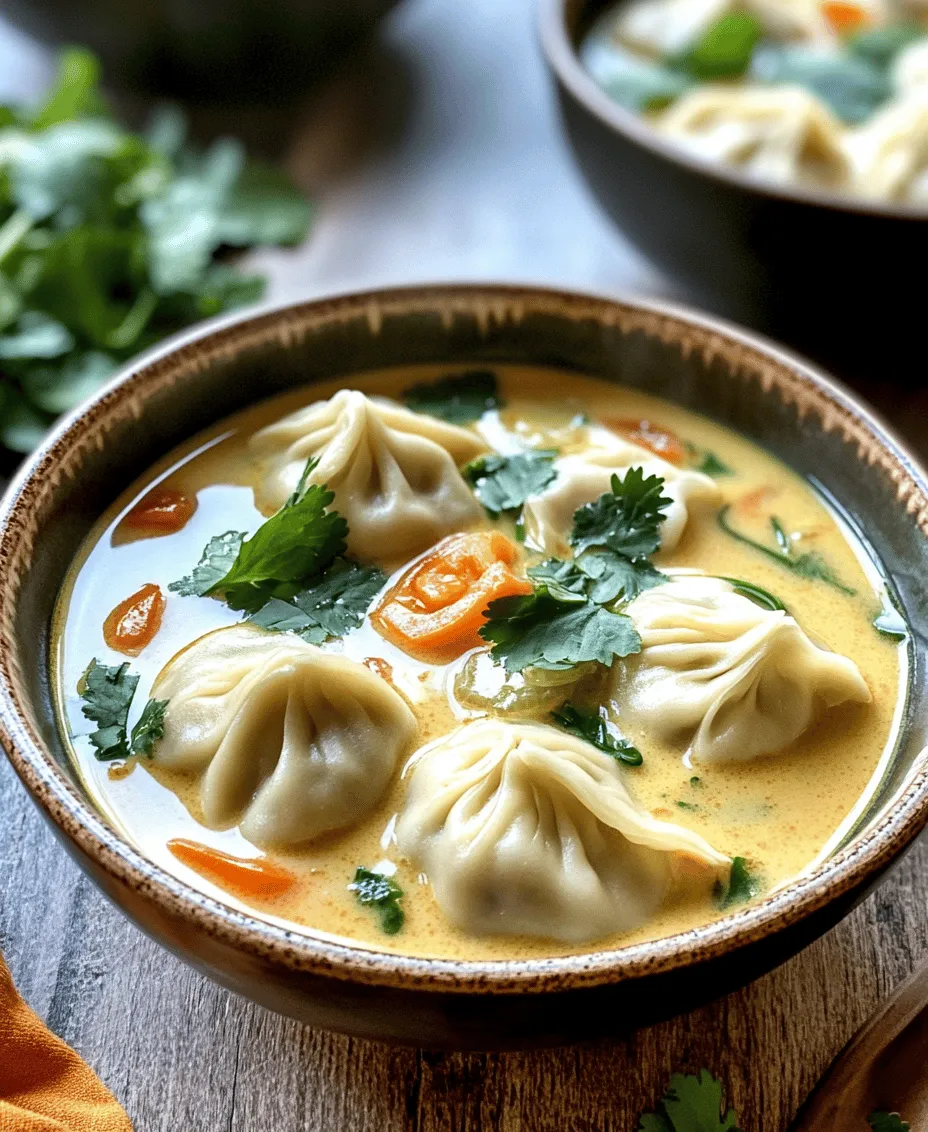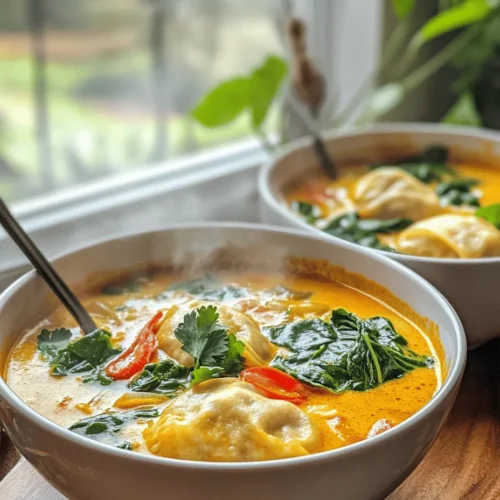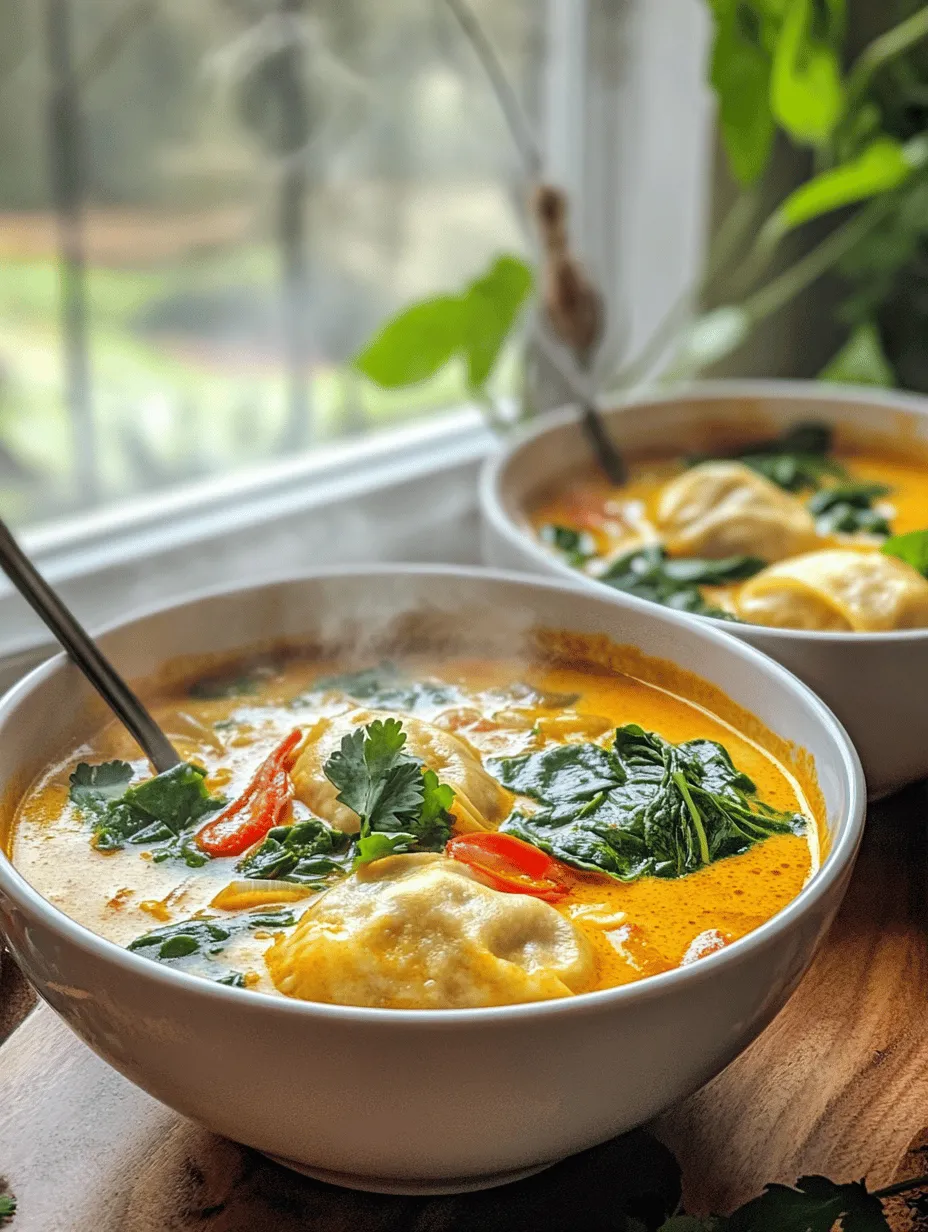Introduction
Asian cuisine is a treasure trove of flavors, textures, and aromas, with each dish telling a story steeped in cultural significance and tradition. Among the many comforting dishes that grace the tables of Asian households, curry dumpling soup stands out as a beloved favorite. This dish skillfully marries the soft, chewy dumplings with a rich, aromatic soup, creating a culinary experience that warms the heart and excites the palate. In this article, we will delve deep into the recipe for the Best Curry Dumpling Soup, taking you on a journey through its origins, the ingredients that make it exceptional, and the preparation steps that lead to a bowl of pure comfort.
The Allure of Curry Dumpling Soup
Exploring the Origins of Dumplings
Dumplings have a storied history that spans cultures and continents. Originating in Asia, they have been a staple for centuries, evolving into myriad forms and fillings that represent regional flavors and culinary traditions. From the delicate potstickers of China to the hearty pierogi of Eastern Europe, dumplings have captured the hearts and stomachs of people around the globe. The versatility of dumplings lies in their ability to adapt, making them suitable for various occasions—from everyday meals to festive gatherings. In the context of curry dumpling soup, these delightful morsels are filled with savory ingredients that complement the spiced broth, making them a perfect match for the warming essence of soup.
Understanding the Cultural Significance of Curry in Different Cuisines
Curry, a term that encapsulates a wide range of dishes, spices, and cooking techniques, has its roots in South Asian cuisine but has transcended geographical boundaries. With its bold flavors and aromatic spices, curry is not just a dish; it’s a culinary tradition that carries cultural significance across various countries. In India, curry is a celebration of spices, often featuring a complex blend of ingredients that vary by region. In Thailand, curry is characterized by its use of fresh herbs and coconut milk, creating a balance of heat and sweetness. The incorporation of curry into dumpling soup represents a fusion of these rich culinary heritages, resulting in a dish that is both comforting and invigorating.
Why Soup is the Ultimate Comfort Food
Soup, in its many forms, has long been synonymous with comfort food. It evokes nostalgia, providing a sense of warmth and security, often associated with home-cooked meals and family gatherings. The liquid base of soup serves not only to hydrate but also to carry flavors, creating a harmonious blend that soothes the soul. In the case of curry dumpling soup, the combination of creamy coconut milk, fragrant spices, and hearty dumplings creates a comforting embrace for the senses. Whether enjoyed on a chilly evening or as a remedy for a cold, this soup embodies the essence of comfort while also allowing for creativity in the kitchen.
Ingredients Breakdown
To create the Best Curry Dumpling Soup, it’s essential to gather high-quality ingredients that will contribute to the overall flavor and texture of the dish. Below is a detailed breakdown of the ingredients required for both the dumplings and the soup base.
Essential Ingredients for Dumplings
– All-Purpose Flour: The Base of the Dumpling Dough
All-purpose flour serves as the backbone of the dumpling dough, providing the necessary structure and chewiness. It’s important to choose a high-quality flour for the best results. The right balance of flour and water will ensure that the dough is pliable yet sturdy enough to hold the flavorful filling.
– Flavorful Fillings: Green Onions, Mushrooms, and More
The filling is where the magic happens. For our curry dumplings, finely chopped green onions and mushrooms create a savory base. You can also experiment with other ingredients like ground meat, tofu, or even seasonal vegetables, allowing the dumplings to reflect your personal taste and preferences.
– Aromatic Additions: Ginger and Garlic
No Asian dish is complete without the aromatic duo of ginger and garlic. Their pungent flavors infuse the filling with warmth and depth, enhancing the overall taste of the dumplings. Freshly minced ginger adds a spicy kick, while garlic provides a robust undertone, making each bite a burst of flavor.
Ingredients for the Soup Base
– Vegetable Broth: The Heart of the Soup
High-quality vegetable broth serves as the foundation for our curry dumpling soup. It not only adds depth of flavor but also complements the other ingredients seamlessly. For the best results, consider making your own broth or choosing a low-sodium store-bought option to control the saltiness of the dish.
– Coconut Milk: Creaminess and Flavor
Coconut milk is a quintessential component of many curry-based dishes, providing a creamy texture and subtle sweetness that balances the spices. It enriches the soup, ensuring each spoonful is smooth and velvety. Using full-fat coconut milk will give the soup a luxurious mouthfeel.
– Spices: The Role of Red Curry Paste
Red curry paste is the star of our soup base, delivering a burst of flavor and warmth. This vibrant paste is typically made from a blend of red chili peppers, garlic, ginger, lemongrass, and other spices, creating a complex flavor profile. The amount used can be adjusted according to your spice tolerance, making it easy to customize the heat level of the soup.
Preparing the Dumplings
Now that you have gathered all the necessary ingredients, it’s time to embark on the journey of creating your dumplings. The process involves mixing the dough, filling it with flavorful ingredients, and shaping them into perfect parcels.
Mixing the Dough: Techniques and Tips
The first step in making dumplings is preparing the dough. Begin by combining all-purpose flour with hot water, which is crucial for achieving the right texture. The hot water helps to activate the gluten in the flour, resulting in a dough that is soft and elastic.
1. Combine the Ingredients: In a large mixing bowl, add 2 cups of all-purpose flour and gradually pour in about ¾ cup of hot water. Use chopsticks or a fork to mix the flour and water until it starts to come together.
2. Knead the Dough: Once the mixture is cool enough to handle, transfer it to a floured surface and knead it for about 5-10 minutes until the dough is smooth and elastic. If the dough is too sticky, add a little more flour as needed.
3. Rest the Dough: After kneading, cover the dough with a damp cloth or plastic wrap and let it rest for at least 30 minutes. Resting allows the gluten to relax, making it easier to roll out later.
Filling the Dumplings: Ensuring Maximum Flavor
While the dough is resting, it’s time to prepare the filling. The key to flavorful dumplings lies in the balance of ingredients.
1. Prepare the Filling: In a mixing bowl, combine 1 cup of finely chopped mushrooms, ½ cup of chopped green onions, 1 tablespoon of minced ginger, and 1 tablespoon of minced garlic. You may also add ½ cup of cooked ground meat or tofu, depending on your preference.
2. Season the Mixture: Add soy sauce, sesame oil, salt, and pepper to taste. Mix well to ensure that all ingredients are evenly distributed. Taste the filling and adjust the seasonings as necessary to achieve a flavorful blend.
Shaping Techniques: Achieving the Ideal Dumpling
Once the filling is prepared, it’s time to shape the dumplings. This step requires a bit of practice but can be quite enjoyable.
1. Roll Out the Dough: On a lightly floured surface, divide the rested dough into small portions. Roll each portion into a thin circle, about 3 inches in diameter. It’s important to keep the edges thinner than the center to prevent the dumplings from bursting during cooking.
2. Add the Filling: Place a small spoonful of the filling in the center of each dough circle. Be careful not to overfill, as this can lead to leaks during cooking.
3. Seal the Dumplings: Gently fold the dough over the filling, creating a half-moon shape. Pinch the edges together securely, ensuring no filling escapes. For added security, you can pleat the edges or use a fork to press down and create a decorative seal.
With your dumplings prepared, you’re just a step away from creating an exquisite curry dumpling soup. The next phase involves crafting the aromatic soup that will cradle your dumplings and elevate the entire dish to new heights. Continue to the next section to explore the art of crafting the perfect soup.

Creating the Flavor Base
How to Properly Sauté Red Curry Paste
Sautéing red curry paste is a crucial step in creating a robust flavor base for your curry dumpling soup. Begin by heating a tablespoon of vegetable oil in a large pot over medium heat. Once the oil is shimmering, add the red curry paste. Stir it continuously for about 1-2 minutes until it becomes fragrant and slightly darker in color. This step releases the essential oils in the paste, intensifying the flavors. Be cautious not to burn the paste as it can lead to a bitter taste. If the paste begins to stick or burn, add a splash of coconut milk to deglaze the pot and continue stirring.
Incorporating Coconut Milk and Broth
Achieving the Right Consistency and Flavor Balance
After sautéing the curry paste, it’s time to introduce the coconut milk and broth to your pot. Gradually pour in one can (about 14 ounces) of full-fat coconut milk, stirring well to combine it with the curry paste. This creamy element will enrich the soup and balance the spiciness of the curry. Once the coconut milk is fully integrated, add 3-4 cups of vegetable broth or chicken broth, depending on your preference. Stir the mixture to ensure all ingredients are well combined.
As the soup heats, keep an eye on the consistency. If you prefer a thicker soup, reduce the amount of broth or allow the soup to simmer uncovered for a few more minutes. Conversely, for a lighter soup, add more broth until you reach your desired consistency. Taste the soup at this stage and adjust sweetness, saltiness, or spice levels as necessary.
Adding Vegetables: Timing and Technique
How to Retain Freshness and Color in Your Soup
Adding vegetables to your curry dumpling soup not only enhances the nutritional value but also contributes vibrant colors and flavors. Ideal vegetables include spinach, carrots, and mushrooms, which complement the curry base beautifully.
For this recipe, begin with 1 cup of sliced carrots and 1 cup of sliced mushrooms. Add these vegetables to the pot once the soup base is simmering. Cooking them for about 5 minutes will allow them to soften while retaining their vibrant colors. The key is to add delicate greens like spinach last. Stir in 2 cups of fresh spinach just a minute or two before serving. This ensures that the spinach wilts perfectly without losing its bright green hue and nutritional benefits.
Cooking the Dumplings in the Soup
Timing is Key: Ensuring Perfectly Cooked Dumplings
Cooking the dumplings in the soup is a simple yet crucial step in achieving a harmonious flavor. If you’re using store-bought dumplings, follow the package instructions for cooking times. If they are freshly made, they will likely need about 5-7 minutes to cook through in the simmering soup.
To ensure that the dumplings cook evenly, carefully add them to the pot. Space them apart to prevent sticking. The dumplings are done when they float to the top of the soup, indicating that they are cooked through. This floating technique is key to ensuring you don’t overcook them, which can lead to a doughy texture.
Adjusting Seasoning: The Final Touches
Balancing Flavors with Salt, Pepper, and Lime Juice
Once the dumplings are cooked, taste your soup again to ensure it’s perfectly seasoned. Depending on your preference, you may want to add more salt or pepper. A squeeze of fresh lime juice can brighten the flavor and enhance the overall taste of your curry dumpling soup. Start with half a lime, stir, and adjust according to your taste. The acidity from the lime juice acts as a counterbalance to the richness of the coconut milk, rounding out the flavors beautifully.
Serving Suggestions
Presenting Your Curry Dumpling Soup
Presentation plays an essential role in the dining experience. Ladle the curry dumpling soup into deep bowls, ensuring that each bowl gets an even distribution of dumplings and vegetables. For an extra touch of elegance, garnish each serving with a generous handful of fresh cilantro. The bright green herbs not only add a pop of color but also enhance the aromatic profile of the dish.
Pairing Ideas: What to Serve with Your Soup
To create a complete meal, consider pairing your curry dumpling soup with complementary side dishes. A simple green salad with a light vinaigrette can provide a refreshing contrast to the rich soup. Alternatively, serve it with steamed jasmine rice or a side of crusty bread for dipping. For drinks, a light, fruity beverage such as iced tea or a crisp white wine can enhance the meal without overpowering the flavors of the soup.
Nutritional Benefits of Curry Dumpling Soup
Health Benefits of Key Ingredients
Curry dumpling soup is not only delicious but also packed with nutritious ingredients. Spinach is an excellent source of vitamins A, C, and K, as well as iron and magnesium. Mushrooms provide essential nutrients like selenium and B vitamins, while carrots offer beta-carotene, crucial for eye health. The combination of these ingredients makes this soup a wholesome choice for a balanced diet.
Exploring Vegetarian and Vegan Aspects of the Recipe
This recipe can easily be adapted for both vegetarians and vegans. Using vegetable broth and ensuring that the dumplings are made with plant-based ingredients will keep the dish entirely vegan. The reliance on fresh vegetables and coconut milk also contributes to a balanced diet, providing healthy fats, fiber, and a plethora of vitamins and minerals.
Conclusion
Curry dumpling soup is more than just a meal; it’s an experience that combines tradition, flavor, and nourishment. Through this article, we’ve dissected the recipe to reveal its components, techniques, and the joy of bringing it to life in your kitchen. Whether you’re an experienced home cook or a novice, this dish promises to deliver comfort and satisfaction, making it a perfect addition to your culinary repertoire. Enjoy the warmth and flavors of this delightful soup, and let it inspire your culinary journey.



